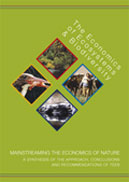Mainstreaming the economics of nature (TEEB)
A synthesis of the approach, conclusions and recommendations of TEEB /The Economics of Ecosystems and Biodiversity / 2010
 The TEEB research forms the core reference point for current thinking on the valuation of nature. This synthesis report was presented at the Convention on Biological Diversity meeting in Japan in 2010 (CBD COP-10, Nagoya).
The TEEB research forms the core reference point for current thinking on the valuation of nature. This synthesis report was presented at the Convention on Biological Diversity meeting in Japan in 2010 (CBD COP-10, Nagoya).
Read report
TEEB aims to “act as a catalyst to help accelerate the development of a new economy: one in which the values of natural capital, and the ecosystem services which this capital supplies, are fully reflected in the mainstream of public and private decision-making”.
The TEEB report defines natural capital as: “an economic metaphor for the limited stocks of physical and biological resources found on earth, and of the limited capacity of ecosystems to provide ecosystem services”.
The types of ecosystem services identified include
- Provision: Food.
- Regulation: Pollination by insects.
- Support: Habitats for species.
- Cultural: Tourism.
See the full list of ecosystem services.
Examples of the TEEB approach
Conserving forests avoids greenhouse gas emissions worth US$ 3.7 trillion: Halving deforestation rates by 2030 would reduce global greenhouse gas emissions by 1.5 to 2.7 GT CO2 per year, thereby avoiding damages from climate change estimated at more than US$ 3.7 trillion in NPV terms. This figure does not include the many co-benefits of forest ecosystems (Eliasch 2008).
The TEEB approach can be summarised as:
1) Recognising value (either monetary or non-monetary) so that nature is not invisible.
2) Demonstrating value in economic terms so trade-offs are fully understood. This could be via presentation of different scenarios and/or including natural capital stocks in national accounts.
3) Capturing value by incorporating the values of ecosystems into decision-making through incentives and price signals e.g. tax breaks, payment for ecosystem services (PES).
Natural capital and poverty reduction
The report highlights the high level of dependence of the poorest rural peoples on the environment for their incomes and areas in which to live (e.g. access to fresh drinking water and flood control).
“Sustainable management of natural capital is thus a key element to achieving poverty reduction objectives as reflected in the Millennium Development Goals”.
TEEB recommends that public spending and development aid (ODA) are targeted “at maintaining or rebuilding ecological infrastructure [that] can make significant contributions to poverty reduction
Payments for Ecosystem Services (PES)
PES has been applied in some cases to forests. “The basic idea is that landowners or communities should be rewarded for practices that keep forests intact and maintain their services.”
The TEEB report highlights the importance of the REDD+ initiative (Reduce Emissions from Deforestation and Forest Degradation) as a means to increase funding for forest conservation and income for rural communities. The report says “avoiding deforestation is an economically attractive option due to the fact that it is among the cheapest ways of reducing emissions, in terms of dollars per tonne of carbon (McKinsey 2009; Eliasch 2009), and also because it secures further ecosystem and biodiversity benefits.”
There are still some issues to be resolved at the UN climate change negotiations on REDD+ including respect for the rights of indigenous peoples and whether governments and the private sector will be able to use investments in REDD (carbon credits) to claim they have reduced their emissions.
Urban areas
The fact that potentially 80% of the world’s population will live in urban areas by 2050 presents a huge challenge. The TEEB report calls for governments to recognise the ecological footprints of cities and to include valuation of natural capital in decision-making. This includes green urban planning (Curitiba in Brazil and Singapore’s ‘garden city’) as well as factoring in natural capital when providing essential services for cities (ecoBudget in the Phillipines and the decision by New York city authorities not to build a an expensive water treatment plant).
Private sector
Business should begin to apply the TEEB approach because there is increasing understanding of their impact on the environment. A UN study showed that 3,000 listed companies are responsible for US$2 trillion of externalities (such as greenhouse gas emissions and water pollution).
TEEB recommends business:
- Recognises the importance of ecosystem services for business operations e.g. huge quantities of fresh water used in the mining industry
- Recognises the business opportunities provided by conservation and sustainable use of biodiversity
The report then covers the concepts of No Net Loss and Net Positive Impact using the example of the mining and quarrying sector. This enables companies to restore and enhance mines and quarries that “can create wildlife habitats such as wetlands, sometimes with greater biodiversity value than the land use that preceded the mining or quarrying activity.”
Another way companies can compensate for environmental damage is through biodiversity offsetting. In the United States a system of Wetland Mitigation Banking worth between US$1.1-1.8 billion is already under way where “developers are obliged to compensate for damage to wetlands, either directly or by purchasing credits from third parties, based on the restoration of wetlands in the same watershed.”
Read report
————————————
This summary was prepared by Why Green Economy?. The views expressed have been paraphrased. See the original source for more information.

Leave a Reply